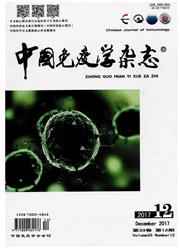

 中文摘要:
中文摘要:
目的探讨甘露聚糖结合凝集素(mannan-bindinglectin,MBL)对肽聚糖(peptidogly—can,PGN)刺激佛波酯(PMA)活化的THP-1/CD14细胞产生TNF—α和IL-6影响。方法用PMA活化THP-1/CD14细胞,以不同浓度人MBL预处理2b后再用PGN刺激24h。收集培养上清,以ELISA从蛋白水平分析TNF-α和IL-6的产生。收集细胞提取总RNA,以RT—PCR从转录水平评估TNF—α和IL-6的表达。FACS分析MBL与THP-1/CD14细胞的结合,并进一步分析MBL对PGN结合THP-1/CD14细胞的影响,Western blot分析NF-κB的细胞核移位。结果ELISA检测发现,PGN可刺激PMA活化的各THP-1/CD14细胞分泌TNF-α和IL-6,高浓度MBL(10~20mg/L)可抑制PGN诱导细胞分泌TNF—α和IL-6;RT—PCR分析亦显示,MBL(20mg/L)对PGN诱导的TNF—α和IL-6的mRNA表达有不同程度的抑制作用;流式细胞术检测显示MBL能够与THP-1/CD14细胞以Ca^2+依赖形式结合,PGN可竞争性抑制MBL结合THP-1/CD14细胞。MBL还可通过结合THP-1/CD14竞争性抑制PGN与THP-1/CD14的结合。Western blot分析显示,MBL对PGN诱导的NF—κB细胞核移位有显著的抑制作用。结论MBL通过配体结合抑制PGN诱导的THP-1/CD14细胞产生的细胞反应,提示MBL能够在PGN诱导的炎性反应中起免疫调控作用。
 英文摘要:
英文摘要:
Objective To investigate the effects of mannan-binding leetin(MBL) on TNF-α pro- duction induced by peptidoglyean (PGN) and its mechanism in human THP-1/CD14 monocytes. Methods The THP-1/CD14 cells were stimulated for 24 h with PGN at the indicated ratios after pretreated with human natural MBL at concentrations ranging from 1 to 20 mg/L for 2 h. The content of TNF-α and IL-6 in culture supernatants were detected by ELISA, and the levels of TNF-α and IL-6 mRNA expressions in these cells were determined by RT-PCR. FACS was used to investigate the interaction of MBL with THP-1/ CD14 cells and the impact of MBL on PGN binding to THP-1/CD14 cells. Western blot was used to detect PGN-induced NF-KB transloeation in THP-1/CD14 cells. Results ELISA showed that secretion of TNF-α and IL-6 from THP-1/CD14 cells could be induced by PGN;The productions of TNF-α and IL-6 by THP-1/ CD14 cells induced with PGN were profoundly inhibited by MBL at higher concentrations ( 10-20 mg/L) but not MBL at lower concentrations ( 1 mg/L). RT-PCR analysis also indicated that the mRNA expressions of TNF-α and IL-6 in THP-1/CD14 cells were decreased by MBL at higher concentration,compared to the corresponding THP-1/CD14 cells stimulated with PGN only. FACS showed that the binding of MBL to THP-1/ CDI4 ceils was evident in a Ca^2+-dependent manner. PGN could competitively inhibit the binding of MBL to THP-1/CD14 cells. MBL could competitively inhibit the binding of PGN to THP-1/CD14 cells by binding to THP-1/CD14 ceils directly. Similarly, MBL at higher concentration (20 mg/L) decreased the NF-KB translocation in THP-1/CD14 cells. Conclusion MBL may inhibit TNF-α and IL-6 production induced by PGN in THP-1/CD14 ceils through NF-KB signaling pathways, suggesting that MBL can play some roles in the regulation of PGN-induced inflammatory response.
 同期刊论文项目
同期刊论文项目
 同项目期刊论文
同项目期刊论文
 Mannan-Binding Lectin Inhibits Candida albicans-Induced Cellular Responses in PMA-Activated THP-1 Ce
Mannan-Binding Lectin Inhibits Candida albicans-Induced Cellular Responses in PMA-Activated THP-1 Ce 期刊信息
期刊信息
